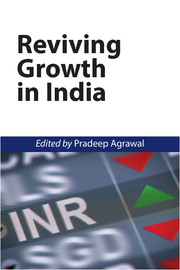Book contents
- Frontmatter
- Contents
- List of Tables and Figures
- Preface
- Section 1 The importance of growth
- Chapter 1 Introduction: Reviving Growth in India
- Chapter 2 Economic Growth: The Key to Poverty Reduction in India
- Section 2 Reviving growth of industry and exports
- Section 3 The dampeners to growth: Controlling inflation
- Section 4 The supply constraints to growth
- Section 5 Emerging issues in growth: The labour and capital markets
- Contributors
- Index
Chapter 1 - Introduction: Reviving Growth in India
from Section 1 - The importance of growth
Published online by Cambridge University Press: 18 December 2015
- Frontmatter
- Contents
- List of Tables and Figures
- Preface
- Section 1 The importance of growth
- Chapter 1 Introduction: Reviving Growth in India
- Chapter 2 Economic Growth: The Key to Poverty Reduction in India
- Section 2 Reviving growth of industry and exports
- Section 3 The dampeners to growth: Controlling inflation
- Section 4 The supply constraints to growth
- Section 5 Emerging issues in growth: The labour and capital markets
- Contributors
- Index
Summary
India has maintained a growth rate of over 6 per cent per annum for the past 30 years. Over the more recent period between 2000 and 2011, the Indian economy grew impressively at an average rate of about 8 per cent per annum, and even exceeded growth rates of 9 per cent per annum for some years. For a while, it seemed that India could repeat the Chinese miracle, and finally escape the low income trap that it has been in for centuries, to regain its bygone glory as a leading nation of the world. However, over 2011–14, inflation reared its ugly head as India struggled to meet rising food demand and deal with rapidly rising prices of crude oil and other commodities. This was compounded by large fiscal deficits and several populist schemes that created excessive demand for which appropriate supply arrangements did not exist. These supply constraints led to increasing inflation.
At this juncture, very careful steps were needed to be taken by the government to ease the supply constraints, especially to argument food supplies whose demand was rising rapidly with rising incomes, and to find imaginative solutions to increasing crude oil and commodity prices by better demand management and greater use of coal (that India has in abundance) and renewable energy. There was also an urgent need to control the fiscal deficits and avoid excessive spending on subsidies that were not well targeted to the poor. However, the United Progressive Alliance (UPA) government got mired in many corruption scams, which led to erosion of public confidence in and support for the government. The country seemed to drift during this period. The political leadership failed to give clear direction, and were often busy fighting political battles within the coalition and from the growing opposition. Senior bureaucrats hesitated to take decisions and sat on files. These conditions led to a ‘policy paralysis’. Thus, the supply side steps needed urgently to fight food and commodity price inflation were not taken—at least not with sufficient vigour to make a difference.
- Type
- Chapter
- Information
- Reviving Growth in India , pp. 3 - 16Publisher: Cambridge University PressPrint publication year: 2015



